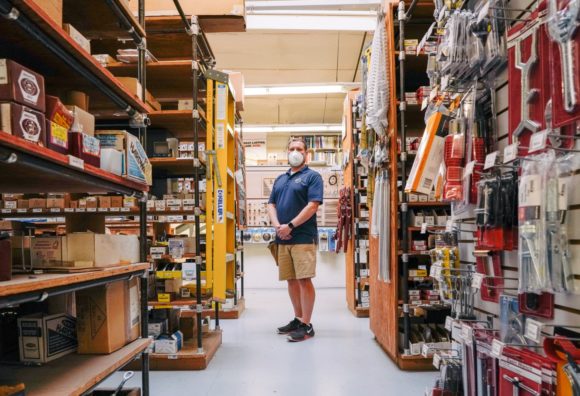Lindsey Major, wracked with asthma, crisscrossed Seattle in search of an N95 mask as wildfire smoke blanketed the West Coast.
The 25-year-old from Mercer Island scoured stores. Pharmacies, big-box outlets, grocers — none had anything to offer. At work, a door was inadvertently left open overnight, saturating the environment with dirty air. Her employer, a local television news operation, had only one mask to spare, and it didn’t fit.
“You can breathe, but it’s like something weighing on your chest,” said Major. “My lungs felt like they were full of wet bands.”
Major finally posted a desperate plea in a neighborhood Facebook group and secured a single precious N95.

The masks are recommended by the U.S. Centers for Disease Control and Prevention to filter out small airborne smoke particles and Covid-19, but they were almost unfindable this month even as air quality in West Coast states ranged from merely unhealthy to hazardous. The pandemic decimated the supply, making it nearly impossible for people like Major to get protection, and federal efforts to increase supply of the staple have fallen short. Fire season has weeks to go.
Dozens of large blazes that have scorched millions of acres in California, Oregon and nine other states marked the beginning of one of the worst wildfire seasons in history. More than 3.7 million acres were burning from active fires as of Thursday, according to the National Interagency Fire Center. Strong winds pushed the smoke into major cities, resulting in unnerving bright orange skies and acrid odor that lasted days.
Local and state health departments advised residents to remain indoors as much as possible. But staying confined is difficult, especially for essential workers, and most homes lack high-grade air filters.
The Trump administration insists that personal protective equipment is plentiful, however doctors and first responders throughout the pandemic have reported rationing and reusing masks.
Making N95 masks requires specialized equipment that few U.S. companies have. In April, President Donald Trump used the Defense Production Act to compel increased production by 3M Co., the biggest U.S. manufacturer. The company expects to produce 95 million masks per month in October, up from 50 million in June.
Officials from seven of eight states who spoke with the Governmental Accountability Office in July and August said they had trouble purchasing personal protective equipment, according to a recent report. However, the administration has been draining resources from the U.S. Strategic National Stockpile, the main program meant to directly supply states with crisis medical supplies — including masks. In August, the administration transferred to its Operation Warp Speed vaccine program $6 billion of $16.7 billion that previously had been allocated to the stockpile.
Emergency mask shipments are hardly making it into the hands of the general public. Last week, Oregon asked the Federal Emergency Management Agency for 1.4 million additional N95 masks, said agency spokeswoman Janet Montesi. The shipment is meant for first responders, shelter operators and health-care workers.
Bedeviled by bad air, some West Coast residents blame the federal government for shortages. Jim Murphy, a San Jose technology consultant who wanted an N95 mask, said the Trump administration should be requiring companies to produce more. He bought N95 masks in January but gave them to relatives with essential jobs.
“If you’re like me, and you have a couple of dogs you need to take out for walks, you have no choice but to get outside,” Murphy said. “It would sure be nice to have something that would protect you from the smoke even for short periods of time.”
Hardware stores have had a hard time sourcing N95 masks since at least March.
Aaron Bourne, the general manager at W.C. Winks Hardware in Portland, Oregon, said his order from 3M has been on hold since Jan. 17. The company provides an estimate for arrival, Bourne said, but it gets pushed back every time it approaches. Winks Hardware, which specializes in hard-to-find items, instead sells Chinese-standard KN95 masks when those are available. The store got a shipment of 100 on Sept. 11, and sold all but 15 that day. The rest were gone soon after they reopened the following Monday.
Other stores have essentially given up. David Rider, who manages a True Value in Grandview, Washington, said there was a surge in demand for air-filtration products. Both N95 and KN95 masks have been out of stock at the store since March.
Rider said he could obtain KN95 masks through his supplier but would need to charge $5 for each.
In spite of the overwhelming demand, experts disagree on whether masks should be worn around wildfire smoke. Oregon’s most populous county, Multnomah, told people to use them when outside. But Joel Kaufman, a doctor and professor of epidemiology at the University of Washington, said they should be reserved for emergency workers close to the fires who have been fitted for them. Most civilians, even the sick, should avoid them, he said.
“The people we worry most about — the people with chronic lung conditions – aren’t good candidates to wear these masks, because the masks increase the amount of work it takes to get air in and out,” Kaufman said. “The folks who need it the most are, sort of, the least able to tolerate wearing them.”
Air-quality scores are now improving in most large cities. On Mercer Island, Major’s asthma symptoms have gotten better, though she worries about the future for herself and people who are more at risk. She hopes more neighbors will come forward with masks to donate.
Was this article valuable?
Here are more articles you may enjoy.


 NYT, Chicago Tribune Sue Perplexity AI as Copyright War Rages On
NYT, Chicago Tribune Sue Perplexity AI as Copyright War Rages On  LA Fires Push Insurers’ 2025 Disaster Losses to $107 Billion
LA Fires Push Insurers’ 2025 Disaster Losses to $107 Billion  Atmospheric River to Flood Pacific Northwest Through Week
Atmospheric River to Flood Pacific Northwest Through Week  Poorer Americans Dropped Federal Flood Insurance When Rates Rose
Poorer Americans Dropped Federal Flood Insurance When Rates Rose 